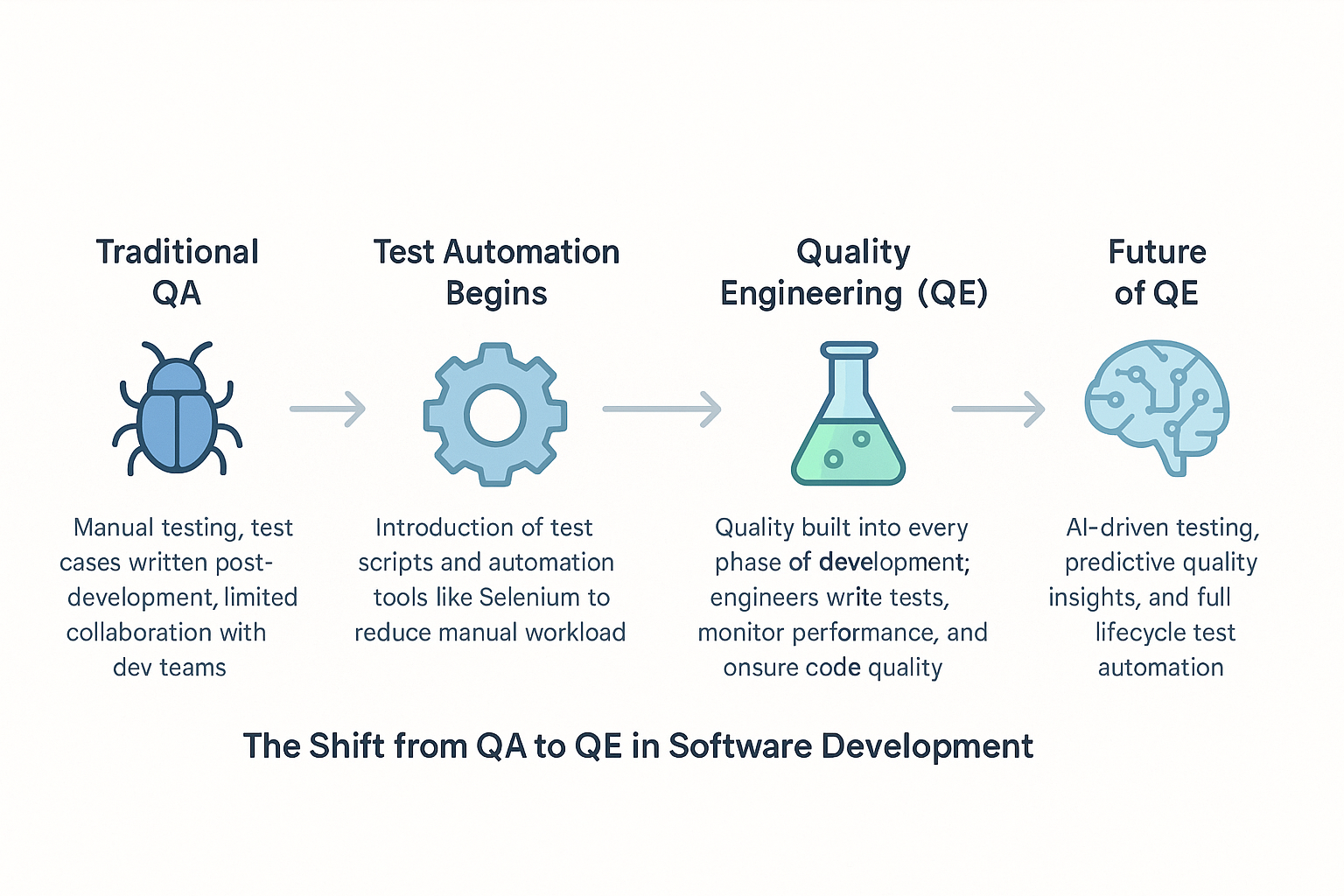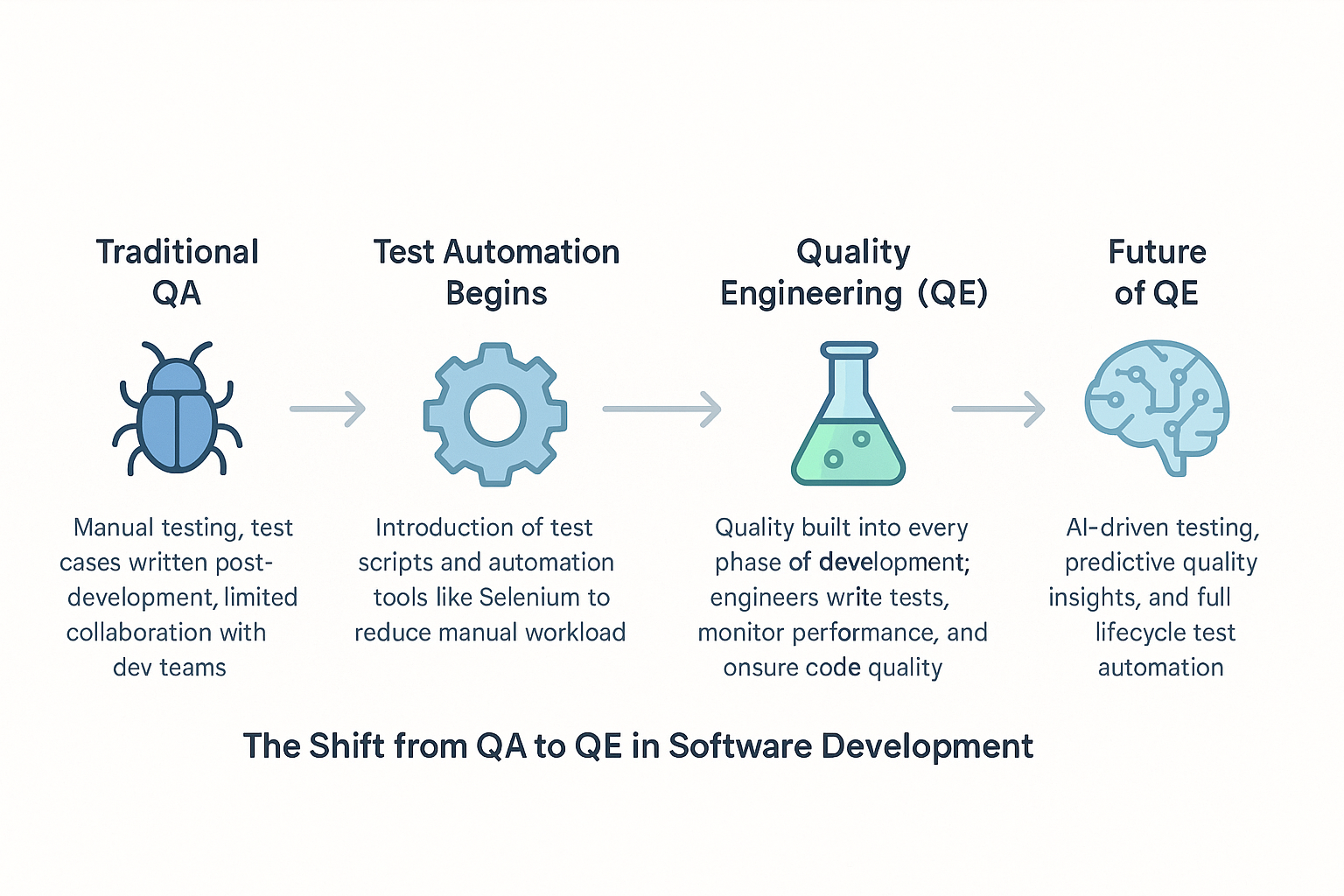In the dynamic world of software development, the roles of Quality Assurance (QA) and Quality Engineering (QE) have become increasingly significant. Although often used interchangeably, QA and QE represent two distinct philosophies and approaches to ensuring software quality. Understanding the difference between QA vs QE isn’t just a matter of semantics; it’s a strategic necessity that can impact product delivery timelines, customer satisfaction, and organizational agility. Quality Assurance has traditionally focused on maintaining standards and preventing defects through structured processes. In contrast, Quality Engineering emphasizes continuous improvement, leveraging automation, integration, and modern development methodologies to ensure quality is built into every stage of the development lifecycle.
As the demand for robust, reliable software grows, the pressure on development teams to produce high-quality products quickly has never been greater. This shift has led to the evolution from traditional QA to modern QE, prompting organizations to rethink how they define and implement quality.
This comprehensive guide will explore:
- Definitions and distinctions between QA and QE
- Historical evolution of both roles
- Key principles, tools, and methodologies
- How QA and QE impact the software development lifecycle
- Real-world applications and use cases
- Strategic advice for choosing and balancing both
Whether you’re a QA engineer looking to future-proof your skills or a tech lead deciding how to structure your quality teams, this post will provide the clarity and insights you need.
Related Blogs
Test Driven Development in Agile Framework
Shift Left Testing Principles: Catch Bugs Early, Deliver Faster

What is Quality Assurance (QA)?
Quality Assurance is a systematic approach to ensuring that software meets specified requirements and adheres to predefined quality standards. QA focuses on process-oriented activities that aim to prevent defects before they reach the end-user.
Key Objectives of QA:
- Detect and prevent defects early
- Ensure compliance with standards and regulations
- Improve the development process through audits and reviews
- Enhance customer satisfaction
Core Practices:
- Manual and automated test execution
- Risk-based testing
- Test case design and traceability
- Regression testing
Real-life Example: Imagine launching a healthcare application. QA processes ensure that critical features like patient data entry, billing, and compliance logging meet regulatory standards before deployment.
What is Quality Engineering (QE)?
Quality Engineering takes a broader and more proactive approach to software quality. It integrates quality checks throughout the software development lifecycle (SDLC), using automation, CI/CD pipelines, and collaboration across teams.
Key Objectives of QE:
- Embed quality throughout the SDLC
- Use automation to accelerate testing
- Foster continuous improvement and learning
- Improve time-to-market without compromising quality
Core Practices:
- Test automation and framework design
- Performance and security testing
- CI/CD integration
- Shift-left testing and DevOps collaboration
Example: In a fintech company, QE engineers automate tests for real-time transaction engines and integrate them into the CI pipeline. This ensures each code change is instantly verified for performance and security compliance.
A Historical Perspective: QA to QE
Origins of QA
QA finds its roots in manufacturing during the Industrial Revolution, where early pioneers like Frederick Winslow Taylor introduced methods to enhance production quality. It later evolved into statistical quality control and eventually into Total Quality Management (TQM).
Rise of QE
As software complexity increased, the need for more adaptive and continuous approaches led to the rise of QE. Emerging technologies like machine learning, cloud computing, and containerization demanded real-time testing and feedback mechanisms that QA alone couldn’t deliver.
Transitioning to QE allowed teams to scale testing, support agile methodologies, and automate redundant tasks.
QA vs QE: What Sets Them Apart?
| S. No | Aspect | Quality Assurance (QA) | Quality Engineering (QE) |
|---|---|---|---|
| 1 | Primary Focus | Process consistency and defect prevention | Continuous improvement and test automation |
| 2 | Approach | Reactive and checklist-driven | Proactive and data-driven |
| 3 | Testing Methodology | Manual + limited automation | Automated, integrated into CI/CD |
| 4 | Tools | ISO 9001, statistical tools | Selenium, Jenkins, TestNG, Cypress |
| 5 | Goal | Ensure product meets requirements | Optimize the entire development process |
| 6 | Team Integration | Separate from dev teams | Embedded within cross-functional dev teams |
Methodologies and Tools
QA Techniques:
- Waterfall testing strategies
- Use of quality gates and defect logs
- Functional and non-functional testing
- Compliance and audit reviews
QE Techniques:
- Agile testing and TDD (Test-Driven Development)
- CI/CD pipelines with automated regression
- Integration with DevOps workflows
- Machine learning for predictive testing
How QA and QE Impact the SDLC
QA’s Contribution:
- Maintains documentation and traceability
- Ensures final product meets acceptance criteria
- Reduces production bugs through rigorous test cycles
QE’s Contribution:
- Reduces bottlenecks via automation
- Promotes faster delivery and frequent releases
- Improves developer-tester collaboration
Use Case: A SaaS startup that transitioned from traditional QA to QE saw a 35% drop in production defects and reduced release cycles from monthly to weekly.
Team Structures and Roles
QA Team Roles:
- QA Analyst: Designs and runs tests
- QA Lead: Manages QA strategy and reporting
- Manual Tester: Conducts exploratory testing
QE Team Roles:
- QE Engineer: Builds automation frameworks
- SDET (Software Development Engineer in Test): Writes code-level tests
- DevOps QA: Monitors quality metrics in CI/CD pipelines
Choosing Between QA and QE (Or Combining Both)
While QA ensures a strong foundation in risk prevention and compliance, QE is necessary for scalability, speed, and continuous improvement.
When to Choose QA:
- Regulatory-heavy industries (e.g., healthcare, aviation)
- Projects with fixed scopes and waterfall models
When to Embrace QE:
- Agile and DevOps teams
- High-release velocity environments
- Need for frequent regression testing
Ideal Approach: Combine QA and QE
- Use QA for strategic oversight and manual validations
- Use QE to drive test automation and CI/CD integration
Conclusion: QA vs QE Is Not a Battle It’s a Balance
As software development continues to evolve, so must our approach to quality. QA and QE serve complementary roles in the pursuit of reliable, scalable, and efficient software delivery. The key is not to choose one over the other, but to understand when and how to apply both effectively. Organizations that blend the disciplined structure of QA with the agility and innovation of QE are better positioned to meet modern quality demands. Whether you’re scaling your automation efforts or tightening your compliance protocols, integrating both QA and QE into your quality strategy is the path forward.
Frequently Asked Questions
-
Is QE replacing QA in modern development teams?
No. QE is an evolution of QA, not a replacement. Both roles coexist to support different aspects of quality.
-
Can a QA professional transition to a QE role?
Absolutely. With training in automation, CI/CD, and agile methodologies, QA professionals can successfully move into QE roles.
-
Which role has more demand in the industry?
Currently, QE roles are growing faster due to the industry’s shift toward DevOps and agile. However, QA remains essential in many sectors.
-
What skills are unique to QE?
Automation scripting, familiarity with tools like Selenium, Jenkins, and Docker, and understanding of DevOps pipelines.
-
How do I know if my organization needs QA, QE, or both?
Evaluate your current development speed, defect rates, and regulatory needs. If you’re aiming for faster releases and fewer bugs, QE is essential. For process stability, keep QA.
The post QA vs QE: Understanding the Evolving Roles appeared first on Codoid.
Source: Read More


